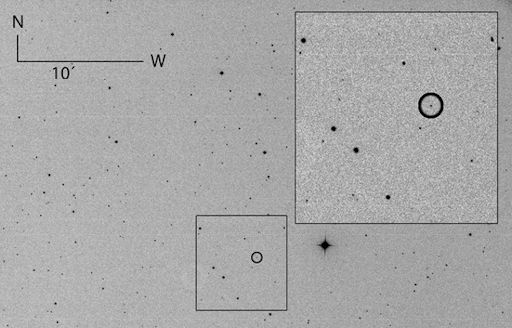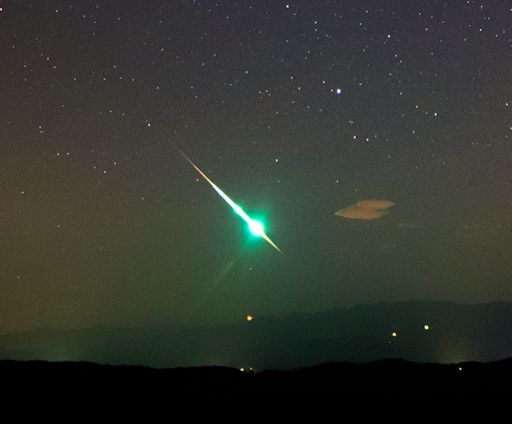At the moment, 2015 TB145 is still a dim speck in the southern constellation Eridanus. Amateur astronomer Marian Urbanik photographed it on Oct. 26th using a remotely controlled 0.43 meter telescope in Siding Springs, Australia:

When Urbanik took the picture, the asteroid was shining like a 16th magnitude star. By the time it reaches the Earth-Moon system on Halloween, it will have brightened 250-fold to 10th magnitude. That's too dim for the naked eye, but an easy target for experienced astronomers with mid-sized backyard telecopes. An article from Sky & Telescope discusses the asteroid's visibility.
2015 TB145 is about 400 meters wide. According to the Minor Planet Center, this is the closest known approach by an object this large until asteroid 1999 AN10 (800 meters wide) approaches Earth at a distance of 238,000 miles in August 2027.
Lance Benner, a radar astronomer at JPL, has raised the intriguing possibility that 2015 TB145 is not an asteroid. "The asteroid's orbit is very oblong with a high inclination to below the plane of the solar system," said Benner. "Such a unique orbit, along with its high encounter velocity -- about 35 kilometers or 22 miles per second -- raises the question of whether it may be some type of comet. If so, then this would be the first time that the Goldstone radar has imaged a comet from such a close distance."
Bron: http://www.spaceweather.com/
... AND HALLOWEEN FIREBALLS:
The "Halloween asteroid" is going to miss Earth. The "Halloween fireballs" might not. If forecasters are correct, gravelly debris from Comet Encke could strike our planet's atmosphere this weekend, producing a display of fireballs like this one:
Marko Korosec took the picture last night in Artvize, Slovenia: "This spectacular meteor had two bright flashes," he says. "It caught me a bit unprepared as I was looking in other direction, saw first flash then looked up and--bam!--the second flash was so bright it lit up the ground."
Korosec says the fireball came from the constellation Taurus, which marks it as a meteoroid from Comet Encke. Most debris from Comet Encke is small, dusty and fragile, yielding meteors of ordinary brightness. Taurid fireballs come from a swarm of particles much larger than normal comet dust. They're about the size of pebbles or small stones. The rocky swarm moves within the greater Encke dust stream, sometimes hitting Earth, sometimes not. Will this Halloween be a hit? Korosec's fireball is an encouraging sign. Stay tuned.
Bron:http://www.spaceweather.com/
Halloween Skies to Include Dead Comet Flyby

Photo NASA
The large space rock that will zip past Earth this Halloween is most likely a dead comet that, fittingly, bears an eerie resemblance to a skull.
Scientists observing asteroid 2015 TB145 with NASA's Infrared Telescope Facility (IRTF) on Mauna Kea, Hawaii, have determined that the celestial object is more than likely a dead comet that has shed its volatiles after numerous passes around the sun.
The belated comet has also been observed by optical and radar observatories around the world, providing even more data, including our first close-up views of its surface. Asteroid 2015 TB145 will safely fly by our planet at just under 1.3 lunar distances, or about 302,000 miles (486,000 kilometers), on Halloween (Oct. 31) at 1 p.m. EDT (10 a.m. PDT, 17:00 UTC).
The first radar images of the dead comet were generated by the National Science Foundation's 305-meter (1,000-foot) Arecibo Observatory in Puerto Rico. The radar images from Arecibo indicate the object is spherical in shape and approximately 2,000 feet (600 meters) in diameter and completes a rotation about once every five hours.
"The IRTF data may indicate that the object might be a dead comet, but in the Arecibo images it appears to have donned a skull costume for its Halloween flyby," said Kelly Fast, IRTF program scientist at NASA Headquarters and acting program manager for NASA's NEO Observations Program.
Managed by the University of Hawaii for NASA, the IRTF's 3-meter (10 foot) telescope collected infrared data on the object. The data may finally put to rest the debate over whether 2015 TB145, with its unusual orbit, is an asteroid or is of cometary origin.

"We found that the object reflects about six percent of the light it receives from the sun," said Vishnu Reddy, a research scientist at the Planetary Science Institute, Tucson, Arizona. "That is similar to fresh asphalt, and while here on Earth we think that is pretty dark, it is brighter than a typical comet which reflects only 3 to 5 percent of the light. That suggests it could be cometary in origin –- but as there is no coma evident, the conclusion is it is a dead comet.”
Radar images generated by the Arecibo team are available at:
https://www.facebook.com/notes/national-astronomy-and-ionosphere-center-arecibo-observatory/near-earth-asteroid-2015-tb145-passes-by-without-a-fright/1082765941733673
Asteroid 2015 TB145 was discovered on Oct. 10, 2015, by the University of Hawaii's Pan-STARRS-1 (Panoramic Survey Telescope and Rapid Response System) on Haleakala, Maui, part of the NASA-funded Near-Earth Object Observations (NEOO) Program. The next time the asteroid will be in Earth's neighborhood will be in September 2018, when it will make a distant pass at about 24 million miles (38 million kilometers), or about a quarter the distance between Earth and the sun.
Radar is a powerful technique for studying an asteroid's size, shape, rotation, surface features and surface roughness, and for improving the calculation of asteroid orbits. Radar measurements of asteroid distances and velocities often enable computation of asteroid orbits much further into the future than would be possible otherwise.
NASA places a high priority on tracking asteroids and protecting our home planet from them. In fact, the U.S. has the most robust and productive survey and detection program for discovering near-Earth objects (NEOs). To date, U.S.-funded assets have discovered over 98 percent of the known NEOs.
In addition to the resources NASA puts into understanding asteroids, it also partners with other U.S. government agencies, university-based astronomers, and space science institutes across the country, often with grants, interagency transfers and other contracts from NASA, and also with international space agencies and institutions that are working to track and better understand these objects. In addition, NASA values the work of numerous highly skilled amateur astronomers, whose accurate observational data helps improve asteroid orbits after they are found.
NASA's Jet Propulsion Laboratory, Pasadena, California, hosts the Center for Near-Earth Object Studies for NASA's Near-Earth Object Observations Program within the agency's Science Mission Directorate.
Bron:http://www.nasa.gov/feature/halloween-skies-to-include-dead-comet-flyby | Gewijzigd: 1 februari 2017, 12:51 uur, door Joyce.s

 Halloween asteroide
Halloween asteroide




